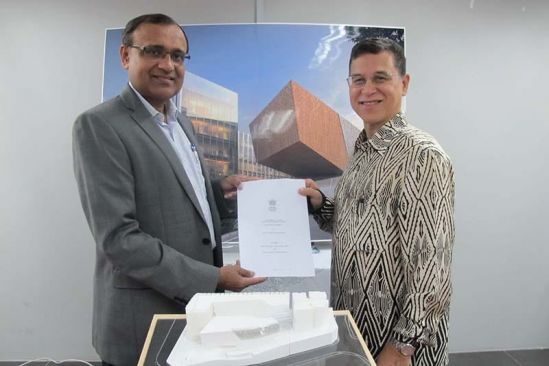VERITAS Design Group is proud to announce on its appointment on the total design package to build the new Indian High Commission at its location in Jalan Duta.
In a handover ceremony recently, the High Commissioner H.E. T. S. Tirumurti handed over the Letter Of Appointment to David Mizan Hashim, President and Chief Executive Officer of VERITAS Design Group.
VERITAS design of the project was selected from amongst ten shortlisted submissions. In response to question as to what was the outstanding criteria in the successful design, the High Commissioner responded, “The design was unique, very contemporary, not bulky. In addition, it was selected on basis of technical, financial and suitability to the High Commission’s requirements. This new building will bring the three offices of the High Commission together in a very flowing manner, namely the Chancery, the Cultural Centre and the Residences. The building is also designed to meet the requirements of Green Building Index and as such environmentally friendly, low in energy. There is open space and gives the design an uplift. It was a unanimous decision as we could imagine the functionality of the design.”
The Indian High Commissioner further added, “Total cost of the project is approximately RM35 million, just for the infrastructure and not including the interior and completion time of building by mid-2020. Interior will be stylishly designed based on India’s traditional heritage and culture. Indian Culture and Heritage are deeply rooted into concept and core design of the High Commission”.
David Mizan Hashim said, “The Indian High Commission design embraces the evolving role of the modern diplomatic mission as a cultural emissary. It aspires as a future forward consulate that seeks greater engagement with the local community and host nation – beyond diplomacy, intelligence and trade.”
The essence of the planning layout lies in the “brahmastana” courtyard, an activity-charged open space carved into the steep topography of the site. The futuristic form of the Chancery façade folds into geometric pleats alluding to the iconic stepwells of India. Whereas the ceremonial façade of the Cultural Centre represents the rich traditional tapestry of art and culture so integral to the Indian identity. Of this façade, the abstracted motif of the Tree of Life, first carved in relief on monumental stone, transitions over to the intricate tracery of a stainless steel Jaali screen that wraps around and defines the Arrival Atrium.







